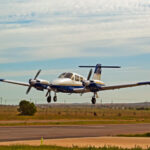Save Lives with FAA Regulated Crash-Resistant Fuel Systems
Helicopters are often used in high-risk operations, and their design must be able to ensure maximum safety for passengers, pilots and crew. One of the most critical aspects of any helicopter is its fuel system, as it plays an essential role in preventing accidents and saving lives. A well-designed crash-resistant fuel system (CRFS) can protect the fuel tanks, fuel lines, and valves from potential hazards such as impact damage or puncture resulting from a collision with obstacles or terrain.
FAA Research
Crash-Resistant Fuel Systems (CRFS) are essential components of any aircraft, as they provide an added layer of safety and protection in the event of a crash. In order to comply with Federal Aviation Administration (FAA) regulations, all aircraft must have a properly designed CRFS in place.
In 2015, the FAA conducted a comprehensive study on the high number of fatal accidents involving helicopters. They found that post-crash fires and blunt force trauma were major contributing factors. Shockingly, only 16% of the US helicopter fleet complied with the 1994 CRFS rule, and only 10% met the 1989 emergency landing certification requirements.
To address the issue, the FAA has mandated that all helicopters manufactured after 2020 must be certified with a CRFS to fly in US airspace. While this is a positive step forward, it may be costly for operators to comply.
A Good CRFS
The design, construction, and configuration of a CRFS can vary depending on size and type of aircraft. However, there are certain common aspects that need to be taken into consideration when designing one such as the recent FAA Technical Standard Order (TSO-C114), fuel tank structure, valve configuration, fuel flow control and more.
The advantages of a quality CRFS should not be underestimated:
- CRFSs reduce the risk of post-crash fires caused by leaking fuel tanks or lines.
- They provide an added layer of safety and protection in the event of a crash, helping to maintain directional control even after experiencing turbulence or being struck by obstacles.
- These systems improve overall passive safety as well as aircraft survivability and structural integrity during accidents, further enhancing passenger safety and saving lives in the process.
- Their design needs to adhere to FAA regulations in order for them to be effective, which includes considerations such as the recent FAA Technical Standard Order, fuel tank structure, valve configuration and fuel flow control.
- Regular maintenance is also critical for ensuring that the CRFS remains in peak condition and works effectively when needed.
In short, a properly designed Crash-Resistant Fuel System is an absolute must for aviation safety while complying with FAA regulations. Its implementation boasts numerous benefits including improved passenger safety, aircraft survivability and structural integrity; ultimately saving lives in the event of an accident.

Company Action
Fortunately, many companies are actively working towards CRFS compliance. Air Methods is leading the way in the air medical transportation industry, and Airbus has been offering retrofit kits at a discounted price of $44,000 worldwide for a year. The European Union Aviation Safety Agency (EASA) is also proposing retrofitting existing rotorcraft and installing CRFS into new helicopters.
Therefore, it is essential for everyone involved in the aviation industry – from passengers to operators – to take an active role when it comes to advocating for the use of CRFS technology. Supporting research and development initiatives that strive to further enhance these systems is also critical in improving aviation safety standards worldwide.









